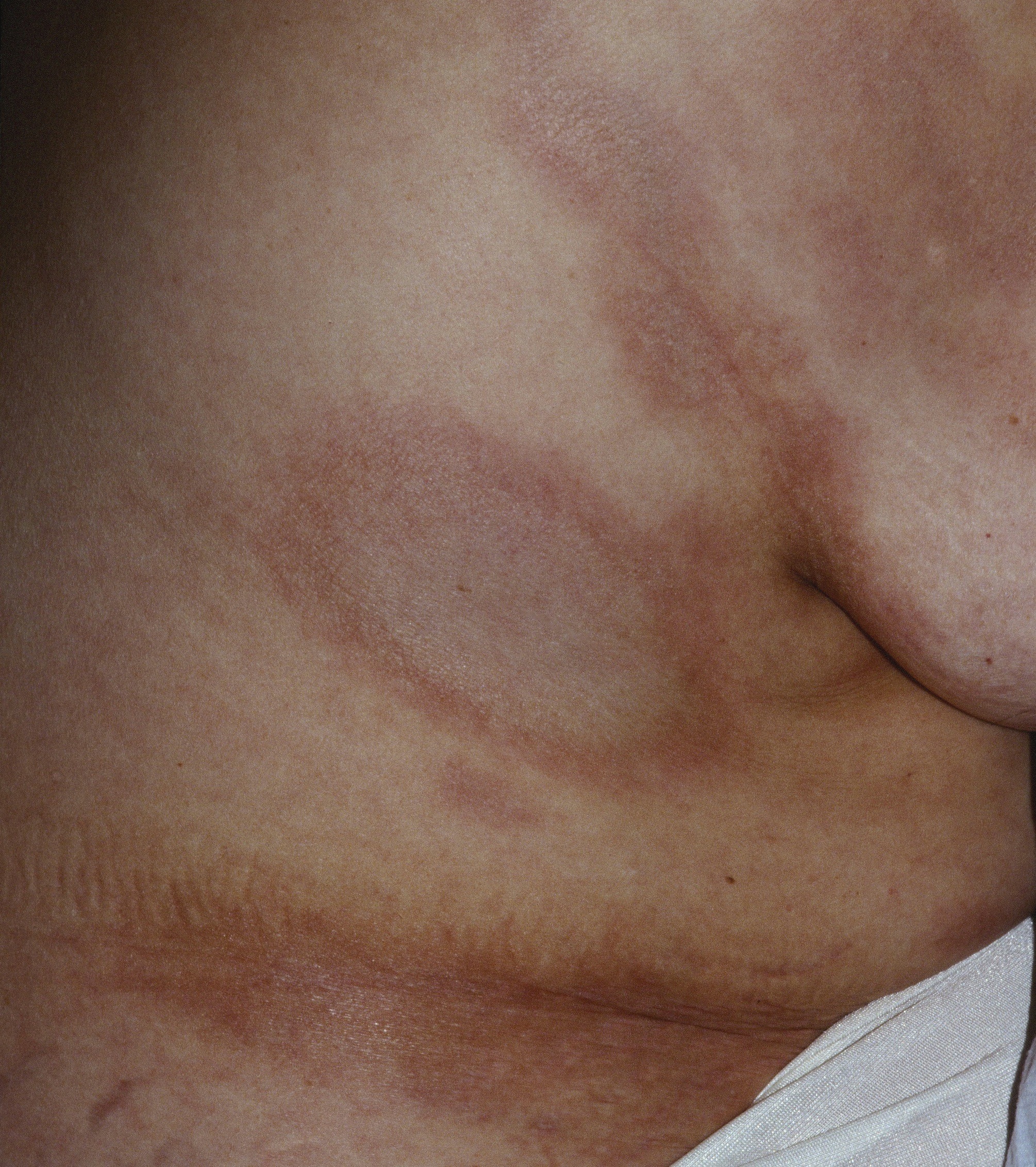
Morphea, aka localized scleroderma, is a fibrotic condition of the skin in which indurated plaques develop. It is most common in adult women on the trunk, but may occur in children as well.
| Disease | Features |
|---|---|
| Morphea (Localized) | Indurated, sclerotic plaques, usually on the trunk. |
| Generalized Morphea | Two or more body regions involved. May have muscle atrophy, but no systemic involvement. |
| Superficial Morphea | Multiple hypopigmented to hyperpigmented patches and plaques. They usually involve intertriginous sites symmetrically and lack significant induration, contractures, or atrophy. |
| Progressive Systemic Sclerosis | Raynaud's, woody edema of hands, sclerodactyly, internal organ involvement, e.g., pulmonary fibrosis. |
| CREST Syndrome | Calcinosis, Raynaud's, esophageal dysmotility, sclerodactyly, and telangiectasias. |
| Linear Scleroderma | Linear indurated lesions. May follow lines of Blaschko. |
| Morphea Profunda | Process involves the deep subcutaneous tissue including the fascia. |
| Pansclerotic Morphea | Widespread involvement of the deeper tissue including the fat fascia, muscle, and bone. |
| Atrophoderma of Pasini and Pierini | Brown, atrophic depressed lesions, usually on the trunk of women. |
| Linear Atrophoderma of Moulin | Similar to APP but linear and may follow lines of Blaschko. |
| En Coup de Sabre | Linear atrophic, indurated lesion running along scalp and forehead. |
| Parry Romberg Syndrome | Atrophy of one side of the facial skin with possible involvement of the muscle, fat, cartilage, bone, and brain. |
Cases of morphea occurring only in the radiation port of breast cancer patients have been reported.
Solitary or multiple areas of erythema and induration in a woman is characteristic. Morphea in middle-aged women often occurs at sites of pressure. The center may develop an ivory color and a surrounding violaceous halo. The trunk and proximal extremities are typically involved. In general, patients with morphea should not have disease of the face (e.g., restriction of opening the mouth, telangiectatic mats) or distal extremities (e.g., Raynaud's phenomenon, dilated capillary loops, acrosclerosis). These findings would indicate systemic sclerosis.
Very rarely, patients may go on to develop systemic sclerosis. Nodular lesions may rarely develop. Generalized morphea is characterized by widespread skin involvement (no consensus on criteria for diagnosis, but one article defined it as four or more lesions on at least two areas of the body) but without Raynaud's phenomenon, acrosclerosis, and involvement of internal organs as in scleroderma. Rarely, morphea and lichen sclerosus may coexist (see below). Cases of "bullous morphea" may actually represent secondary appearance of bullous lichen sclerosus. Skin trauma may play a role in the distribution of the skin lesions.
If extensive, checking porphyrin levels may be indicated to rule out the induration associated with porphyria cutanea tarda. If the case occurs outside the US, workup for Borrelia infection should be done. A genital exam should be performed. In one study, 38% of asymptomatic patients with morphea had vulvar lichen sclerosus. Various laboratory tests may be postive in morphea (eg. ANA) but they generally are not required.
Homepage | Who is Dr. White? | Privacy Policy | FAQs | Use of Images | Contact Dr. White